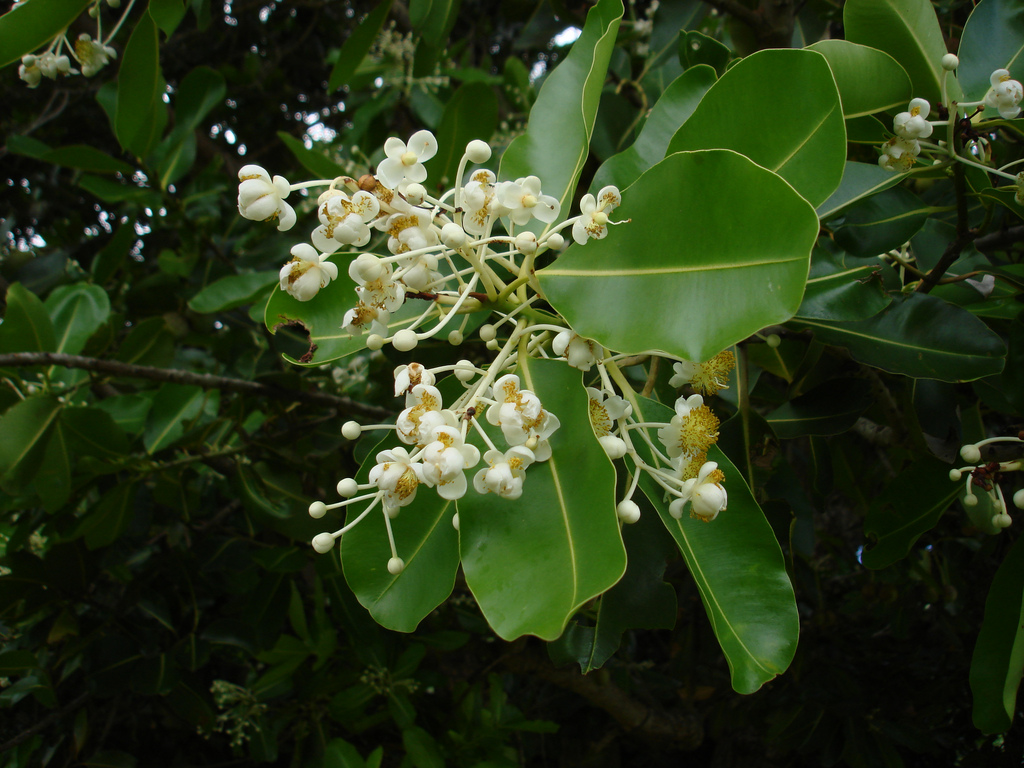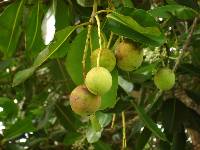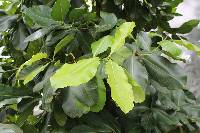
Indomalysia-Pacific; a strand plant, the floating fruit being the dispersal mechanism. Also planted for its hard wood, deep shade, attractive leaves and fragrant, showy flowers. The wood is of excellent quality.
Part of Marine Drive, Agana, from, roughly, the Bank of Hawaii to Moylan's store, is lined with these trees. Agafia (3841); Tumon Bay (5076-a).
A slow-growing but exceedingly handsome tree, resistant to salt spray. Calophyllum inophyllum is widely distributed from tropical East Africa to eastern Polynesia, and although its floating fruits are well adapted to seawater dispersal, it may be a Polynesian introduction to the eastern part of its range. The tree occurs in coastal areas, particularly on rocky, cliff-bound coasts and coastal slopes, where it is often the dominant species, and is sometimes planted as an ornamental in coastal villages. The hard, fine-grained wood is easily worked with stone or metal tools, and for this reason is highly esteemed in Tonga and the rest of Polynesia.
The plant is a large tree up to 25 min height, with 4-angled stems, deeply furrowed and cracked bark, and sticky yellow sap. The simple, oppositely arranged leaves have a finely veined, elliptic to ovate blade 10‒25 cm long. The flowers, arranged in short racemes, are 15‒30 mm across, and have four white petals, four similar white sepals, and numerous yellow stamens. The globose to ovoid drupe is mostly 3‒4 cm across, green at maturity, and contains a single oily seed enclosed within a hard, bony shell.
USES: A decoction of the leaves is given as a bath (kaukau) or steam bath (faka‘ahu) to people believed to be suffering from supernatural ailments (fakamahaki) caused by evil spirits (tevolo). This may be used for treating the ailment directly, or as a closing ceremony (kaukau tuku) after other medicines have been administered. A decoction of the boiled leaves is commonly used as an eyewash for treating various eye ailments. A similar practice is widespread in Polynesia and elsewhere in the Pacific.
Calophyllum inophyllum is widely distributed from tropical East Africa to eastern Polynesia, and although its floating fruits are well adapted to seawater dispersal, it may be a Polynesian introduction to the eastern part of its range. The tree occurs in coastal areas, particularly on rocky, cliff-bound coasts and coastal slopes, where it is often the dominant species, and is sometimes planted as an ornamental in coastal villages. The hard, fine-grained wood is easily worked with stone or metal tools, and for this reason is highly esteemed in Tonga and the rest of Polynesia.
The plant is a large tree up to 25 min height, with 4-angled stems, deeply furrowed and cracked bark, and sticky yellow sap. The simple, oppositely arranged leaves have a finely veined, elliptic to ovate blade 10‒25 cm long. The flowers, arranged in short racemes, are 15‒30 mm across, and have four white petals, four similar white sepals, and numerous yellow stamens. The globose to ovoid drupe is mostly 3‒4 cm across, green at maturity, and contains a single oily seed enclosed within a hard, bony shell.
Copyright ©2018. This sandbox portal development is powered by Symbiota software. Usage Policy.





